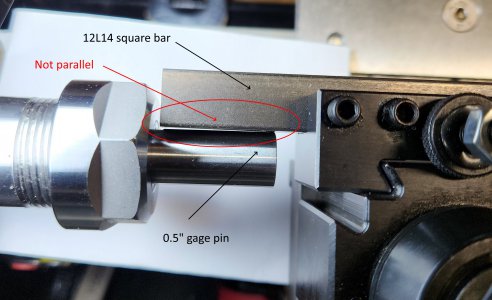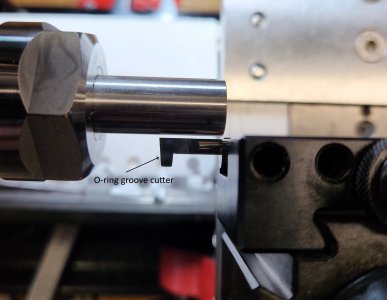For straight-up lathe turning, facing and boring etc., I always start by squaring the compound to the cross-slide, then squaring the QCTP to the compound. I also make sure the cutters are properly installed in the holders, and set screws well secured. For the most part, I think any small cutter misalignment in perpendicularity (turning), or parallelism (boring) with respect to the spindle access isn't a big deal when using single-point cutters; any cutter with a nose radius, unless it's very poorly installed, isn't affected.
I've been working with some profiling cutters that are not single-point; a good example is a cutter used for making inside O-ring grooves. It is radiused at the ends but has a flat in between. It occurred to me I should check to make sure the flat on the cutter is parallel to the spindle axis in order to have the groove itself be flat at the bottom, and symmetrical at its ends.
I chucked a 1/2" gage pin in a 4-jaw and trued it to <0.0002" TIR (static), moved the O-ring grooving tool beside it and brought them in for a dance; because the cutter is small and my eyes aren't what they used to be, I felt certain the tool's edge was not parallel with the gage pin's edge, more evidence needed. I removed the O-ring cutter and replaced it with a piece of 1/2"x1/2" 12L14 I had handy, now I could see the divergence from parallelism more clearly, below is a picture.

What I did next was to loosen the QCTP itself, then I pulled the cross-slide in until the 12L14 bar lay perfectly against the gage pin, then I re-secured the QCTP. Finally, I placed the O-ring cutter back in the holder and brought it's top (non-cutting) side up against the gage pin, it looks parallel now. I also moved it's cutting edge to the gage pin, it now looks good as well. Below is a picture showing the cutter and the gage pin.

I realize there are a lot of parts and pieces which must be perfectly aligned in order for a cutting tool to end up perpendicular, or parallel to the spindle axis, and that in most cases small discrepancies may not materially affect results. I am just curious if anyone else has dealt with this, and if there's a better way to approach it?
Thanks you.
I've been working with some profiling cutters that are not single-point; a good example is a cutter used for making inside O-ring grooves. It is radiused at the ends but has a flat in between. It occurred to me I should check to make sure the flat on the cutter is parallel to the spindle axis in order to have the groove itself be flat at the bottom, and symmetrical at its ends.
I chucked a 1/2" gage pin in a 4-jaw and trued it to <0.0002" TIR (static), moved the O-ring grooving tool beside it and brought them in for a dance; because the cutter is small and my eyes aren't what they used to be, I felt certain the tool's edge was not parallel with the gage pin's edge, more evidence needed. I removed the O-ring cutter and replaced it with a piece of 1/2"x1/2" 12L14 I had handy, now I could see the divergence from parallelism more clearly, below is a picture.

What I did next was to loosen the QCTP itself, then I pulled the cross-slide in until the 12L14 bar lay perfectly against the gage pin, then I re-secured the QCTP. Finally, I placed the O-ring cutter back in the holder and brought it's top (non-cutting) side up against the gage pin, it looks parallel now. I also moved it's cutting edge to the gage pin, it now looks good as well. Below is a picture showing the cutter and the gage pin.

I realize there are a lot of parts and pieces which must be perfectly aligned in order for a cutting tool to end up perpendicular, or parallel to the spindle axis, and that in most cases small discrepancies may not materially affect results. I am just curious if anyone else has dealt with this, and if there's a better way to approach it?
Thanks you.

